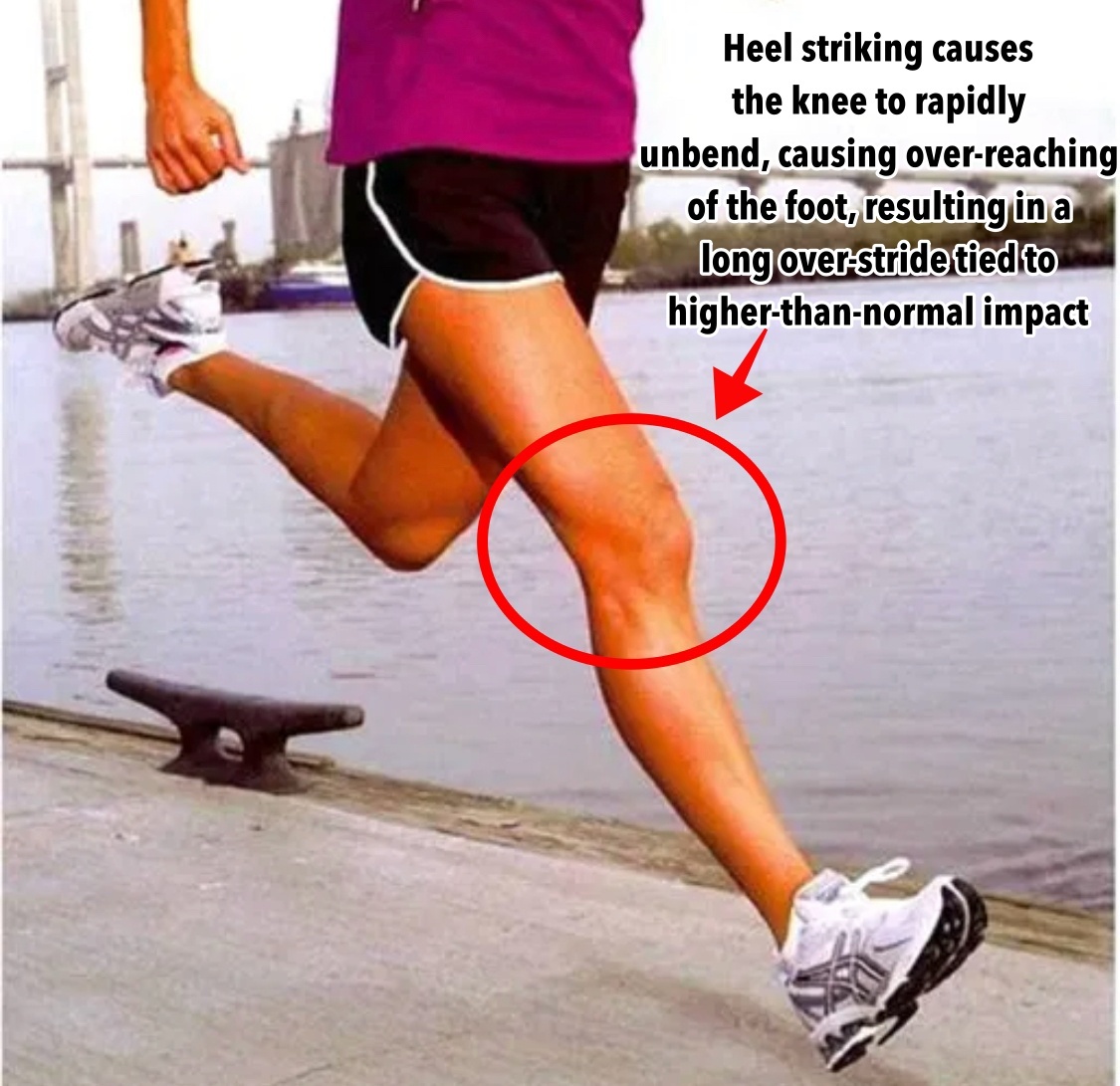If you are a heel strike runner, continued progress will eventually stop because of chronic and severe knee damage, and there is no cushioned running shoe that can avoid this problem.
This is because landing heel-first when running automatically causes the knee-joint to rapidly unbend and straighten-out at landing, which also causes the swing leg to overextend too far ahead of the body, shown below:

Two major studies (references below article) concluded that heel striking and knee extension go hand-in-hand at touchdown, which causes the knee-joint to lock, which in turn, prevents the knee extensors from absorbing energy and impact. The net consequences:
- Impact is amplified because the high impact nature at heel strike increases mechanical work on the knee to bring the vertical velocity of the body segments to zero.
- As a result, impact becomes unattenuated, causing the knee-joint to be overloaded with impact shock.
The risk of knee injury also increases as the speed of heel strike running increases. This is because the rate of rapid deceleration at heel strike increases with running speed, which increases weight-bearing activity on the knee joint.
This is why knee overuse injuries remain high in heel strike runners, which also implies that passive structures, such as the heel pad and shoe cushioning, fail to deliver reliable impact protection. Not only that, science does not support the role of such structures in reducing running-related knee injuries!
Why Forefoot Running is Better for Your Knees, Short and Long-Term!
We should acknowledge that forefoot running is growing increasingly important as the best way to run, not just for your knees, but your shins, hamstrings, hips and lower back. This is because landing with a forefoot strike was found to coordinate more safe, functional knee joint mechanics that influences positive changes to other stride parameters, like a higher step-rate, a shorter stride, more responsive foot steps, and more efficient, faster accelerations. It’s well-sourced (references below article) that these specific mechanical outputs change the impact conditions for the better, resulting in big reductions in the types of stressors responsible for the majority of running injuries.


In terms of proper, safe running form, we now know what the pieces are, and that is a forefoot strike landing, which helps allocate safer ankle, knee, hip-joint angles which in turn are well on record for creating the condition for sustained impact reductions.
Sustained running economy also relies on low-impact production because the lower the impact, the less energy the muscles, soft tissues and tissues use to absorb impact.
Another way forefoot running gives you better gas mileage is by improving the energy-saving capabilities of the Achilles tendon and the arch whereby the more elastic energy you can generate, the better off you are economically. In fact, you can be up to 25% more energy efficient when the Achilles and arch work as a spring, like they do in forefoot running, but not in heel strike running. This is why the top sprinters and long distance runners don’t heel strike. Read more here about why forefoot running is better economically than heel strike running.
References:
[1]. Derrick et al. Energy absorption and impacts during running at various stride lengths. Med Sci Sports Exerc, 1998;30(1):128-135
[2]. Voloshin, A. and J. Wosk. An in vivo study of low back pain and shock absorption in the human locomotor system. J. Biomech. 15:21-27, 1982.

Bretta Riches
BSc Neurobiology; MSc Biomechanics candidate, ultra minimalist runner & founder of RunForefoot. I was a heel striker, always injured. I was inspired by the great Tirunesh Dibaba to try forefoot running. Now, I'm injury free. This is why I launched Run Forefoot, to advocate the health & performance benefits of forefoot running and to raise awareness on the dangers of heel striking, because the world needs to know.
Latest posts by Bretta Riches (see all)
- Can You Run In Barefoot Shoes? Yes, But DON’T Heel Strike! - 21/07/2024
- Why Cushioned Running Shoes Are Really Bad for Your Feet - 19/07/2024
- Do Cushioned Running Shoes Cause Injuries? - 17/07/2024

